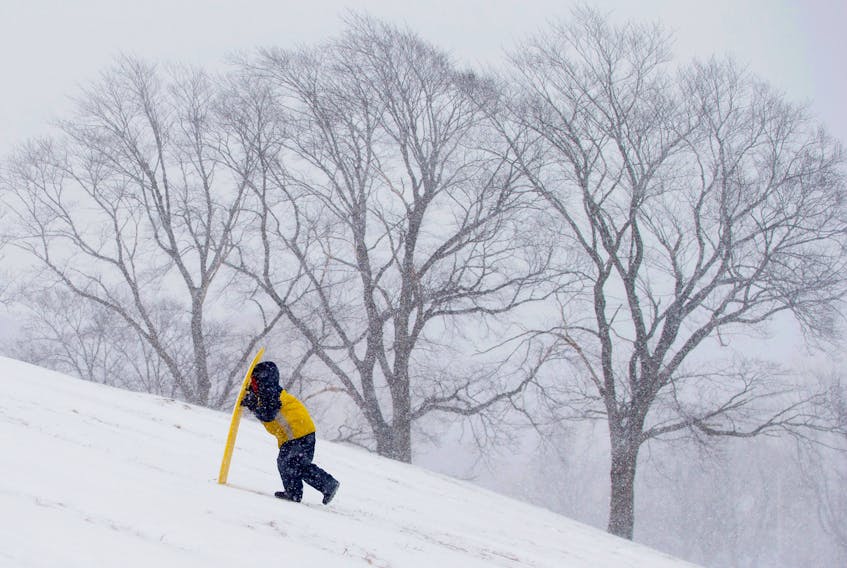Winter storms now set off mass panic in certain parts of Canada, and Nova Scotia is no exception. High anxiety has given rise to relatively new predictions of “Snowpocalypse” or “Snowmageddon.”
The two sensationalist terms are used interchangeably in the media to refer to the approach of a snowstorm. Twice during the month of February, the popular press and social media lit up with sensational, over-the-top, and hilarious reports appropriating those terms. News headlines such as Polar Vortex Storm and the hashtag #Snowmageddon2019 were all the rage.
The latest “Snowmageddon” hit the Maritimes on Wednesday (Feb. 13) and it brought the whole region to a halt, closing every school in all three provinces. For three days leading up to the storm, regional news and weather reports contained dire warnings as the system advanced from Central Canada.
Every school district in Nova Scotia, New Brunswick and Prince Edward Island was on storm alert the day before the event — and all jurisdictions, like clockwork, announced full-system shutdowns.
Initial forecasts of snowfalls ranging from 15 to 30 centimetres were enough to trigger school closure protocols and, as of 6 a.m. on Wednesday, school was cancelled in three provinces, affecting some 733 schools, 18,000 teachers and 235,000 students and families.
The pronounced tendency of Nova Scotia school authorities to declare “snow days” and shut down entire districts was well documented in two reports issued almost 10 years ago, James Gunn’s School Storm Days in Nova Scotia (November 2009) and my own April 2010 AIMS report, School’s Out, Again.
Comparing Maritime school districts with comparable jurisdictions outside the region, it was revealed that our three provincial systems were all more inclined to close their schools during winter storms. In some cities, such as Calgary and Winnipeg, schools never close and, even in districts like the Quebec Eastern Townships, cancellations averaged fewer than three a year.
Whether school is cancelled depends, to a surprising degree, on where you happen to live in Canada. The most recent snowstorm, starting on Feb. 10 in Vancouver and rolling across the country for three days, provided a stark reminder of how different the responses are to heavy snowfalls and storm conditions.
Some 10 cm of snow on Feb. 10 was enough to close schools on the B.C. south coast around Vancouver. Across the Prairies, schools remained open when the thermometer dipped to -30C and kids were advised to cover up to avoid frostbite and hypothermia.
A big snow dump in Ontario and Quebec, hitting on Feb. 12 and 13, finally forced education authorities to either close schools or suspend student busing and leaving student attendance up to “parents’ discretion.”
The Toronto District School Board closed its schools when 7 cm of snow and 18 mm of rain fell on Feb. 12, and that shutdown was only the third time (1996, 2011, and 2019) in two decades. It took 30 cm of snow and rain to close Ottawa schools for the first time in 23 years.
Meteorologists employed by CBC News and CTV Atlantic projected heavy snowfalls of 15 to 40 cm across the Maritime region, issuing storm warnings, and predicting hazardous road conditions. The public, and especially children, were warned to stay home and off the roads.
A featured CBC TV News report, originating in New Brunswick, aired on the eve of the storm and sought to demonstrate how effective and systematic school managers were in executing full-system shutdowns.
When the recent fast-moving storm passed, the snowfall and rain totals fell far short of the projections. Halifax Stanfield International Airport got 21 cm of snow and 22.4 mm of rain, leaving just 7 cm of snow on the ground. That was about one-third of the totals recorded on Feb. 13, 2017, when all schools were closed in Halifax and elsewhere.
Closing the schools on Feb. 13, 2019, left the streets and access highways nearly abandoned, and an eerie quiet descended upon the Halifax downtown. By the next morning, the sun was beaming and the streets remarkably clear.
Some of our regional school districts, such as the Annapolis Valley Regional Centre for Education, are quick to announce system-wide shutdowns. Public schools have already closed from three to 11 times, so far, this year. It’s still a rarity in Ontario, Quebec and the Prairies, where schools remain open even when buses are cancelled because of road conditions.
Nova Scotia and neighbouring provinces are outliers when it comes to system-wide shutdowns. It’s time to find alternatives that reaffirm a provincial commitment to a clearer focus on student learning, the sanctity of instructional time, and improved school attendance.
Paul W. Bennett, Ed.D., is director of Schoolhouse Institute, author of the April 2010 AIMS report, “Schools Out, Again,” and a longtime public advocate of replacing snow days with e-learning days.









